|
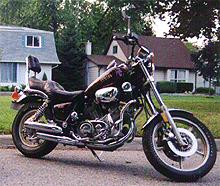 |
| Say goodbye to the
Virago! |
Yamaha recently brought out another cruiser to add to their every increasing
line up, the Yamaha V-Star 1100. Using the already proven Virago power
plant in 1100 format as the heart of the new street warrior, it now
replaces the steadfast Virago 750 and 1100. But first, let's back up
a bit before we go on, shall we?
The Virago came out in the early eighties, its name meaning Amazon
Warrior and was a (rather ugly - 'arris) hybrid of sorts, trying to
combine custom and sport into one machine. That idea was dropped and
a major facelift done in '84, to which it was transformed into the shape
that made it so very popular with the North American motorcycle rider.
I myself own a 1984 Virago 1000 and feel that it and its variants
was so popular, not because it was a direct copy of the American factory
cruiser, but rather a take off on the American Chopper - A home modified
bike with lots of chrome, raked forks, stepped seat, and a sissy bar.
With the cruiser styling enjoying what seems to be an ever-increasing
share of the rider market, the V-Star's arrival comes at an opportune
time.
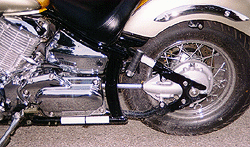 |
|
Lotsa chrome
and an exposed shaft.
|
The V-Star is however very different from the Virago even though many
things have been kept on from its predecessor. You can see this in the
aforementioned power plant, as well as the front brakes, signals, switches,
headlight, mirrors, and grips. Wire spoke wheels retain the Virago's
dual disc brakes up front, something still rare on most cruisers even
today. The bars and polished triple clamps however are now free of gauges
and other useful 'clutter', with just a lone speedo situated in the
centre of the gas tank. The two-tone paint scheme of gold and pewter
is rich in depth and the finish is of high quality. The air-cooled motor
uses richly chromed decoy valve covers to give a very stylish pan look
to the top of the engine. The ample power created by this engine is
delivered to the road via a neat exposed shaft drive. All of this is
attached to the bike by what at first glance looks like a rigid frame
member, but in fact is a swing arm with it's suspension well hidden
from view.
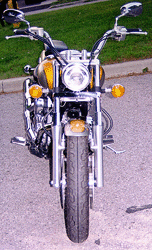 |
When I sat on the V-Star my first thought was of how much wider and
lower Yamaha had made it in comparison to the Virago. Although the bike
still handled very well at low speeds - even around tight 90-degree
corners, a place where many cruisers tend to want to flop into the turn
due to their exaggerated rake angles.
Over the next week I put just over 1000 km on the V-Star in everything
from downtown traffic to wide-open highway, where it proved sure footed,
even in the presence of much larger vehicles and the blast that they
create.
The 1100cc engine had bags of power at the twist of the grip, making
passing a breeze and not a terrifying experience. Don't get me wrong
here, I know this ain’t no R-1, but as far as v-twin cruisers go
the V-Star has more muscle than most, producing smooth reliable power
through all the gears. I wound it out to 165km/h with still plenty of
power left to go, but with the blast from the wind my built in fearometer
was starting to red line. As there is no tach, there is no way to know
what rpm is taking place at that kind of speed, or any other speed for
that matter. But then there was also no sign from the motor that it
was having a difficult time either. At sustained speed the exhaust note
is very tolerable as well, for both the rider and the other motorists
around them. Overall, I found the best speeds (meaning most comfortable
for me) were in the region of 90km-110km/hr.
 |
|
Uncomfortable
passenger seat and hard rear shock.
|
The suspension was great - very comfortable but without the feeling
as though I was riding a pillow. After an hour though, I had the-tell
tale aching ass. The big difference however came when I had a passenger
on board. The ride was much harder, every bump causing the suspension
to bottom out, transferring the shock straight to us (my passenger is
not a big person either). I stopped to see if I could bump up the suspension
but was unable to locate any means to amend the rigid ride home. Perhaps
retaining the dual rear shocks of the Virago over the rigid tail look
would have been a better idea after all. The passenger seat was very
uncomfortable and did not conform to your body; demanding that you conform
to it instead. My passenger also pointed out how close the exhaust pipe
was to the pegs, siting burn marks to the heal of their right boot and
black goo on the muffler.
The lower center of gravity was definitely an asset in rush hour(s)
Toronto traffic. The clutch operation was smooth and the continuous
shifting from 1st to 2nd and back to neutral was easy and quiet. The
air cooled V-twin motor did have a tendency to cook me somewhat however,
but if I wanted air conditioning I could always take the train, right?
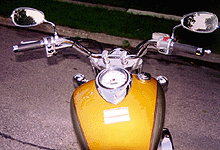 |
| Instrumentation
is located on the tank. |
The only problem I had occurred on the second day when the oil warning
light came on. This unnerving little thing probably went unnoticed for
quite some time, due to the location of all the instrumentation on the
gas tank, which meant that I couldn't quite see the gauge and warning
lights at a glance. I would have to tilt my head forward, taking my
eyes off the road ahead in order to have a look at the Cyclops on the
tank. As a rule, I like looking where I'm going, so I developed a tendency
not to look at the speedometer, just going with the flow of the traffic
instead.
No oil is bad thing for any bike, especially when it's on loan to you.
When the red light finally caught my attention I quickly pulled off
the highway. I let the bike cool down a bit and then checked the oil
level through the little window located way down under the motor. Unlike
the Virago, this task is made somewhat trickier by not having a center
stand. After I had accomplished the required balancing act at the side
of the road, I discovered the oil level to be just fine.
Upon getting home, I called my local Yamaha dealer who already knew
about this problem. Apparently Yamaha were having some trouble with
said light, but since it was coupled to a level sensor, and not an oil
pressure switch, then if the oil level was fine, the bike was safe to
ride. It's a very strange feeling driving around town with the oil light
glaring at you every time you look down. But the motor never blew up,
so I guess it was just an oil level sensor, but still ... really!
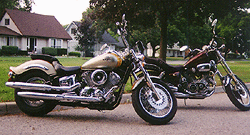 |
|
The V-Star
borrows a lot from the popular Virago - except easy oil changes!
|
As long as I'm on the topic of oil, I'd like to stray off the ride
a bit and get back to my roots, which is mechanics. Normally, routine
maintenance is not discussed during a test ride. There are many reasons
for this; time the bike is on loan, available space, someone to do the
looking over, etc. But because the V-Star is so similar to my own beloved
Virago, I took the liberty to have a quick look at a few things. Everything
seemed straight forward except when it came to an oil change. It would
seem that in order to access the filter you must first remove the front
head pipe. To do this the mufflers have to come off, then the rear brake
master cylinder has to be moved out of the way. With all this done,
it would appear that the head pipe can then be unbolted and removed
to at last enable the oil access cover to be taken off. What a joke!
If you do an oil change hot, better get some asbestos gloves for taking
off those exhaust pipes!
Everywhere I went on the
V-Star I received favourable glances and positive comments from other
riders and passers by, with the exception being that of a certain group
of riders who generally showed disdain, merely because it was a Japanese
Cruiser. However, I really enjoyed riding the V-Star and would give
it some serious thought as my main ride - even with the difficulties
involved in changing the oil. With it’s excellent front brakes,
the tried, tested and punchy 1100 motor in a well finished and competent
rolling chassis. Unfortunately, it has maybe given up too much of the
Virago in the pursuit of appearance, which is fine in most areas, so
long as I don’t have to take anyone along with me.
Sonic.
|